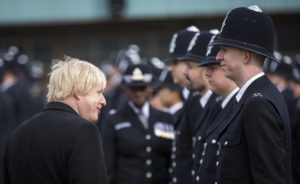I was 12 when we moved to the Cantril Farm Estate in Knowsley. It was July 1976, and we didn’t have much choice: my family had been included in a housing deal to relocate 200,000 council tenants to one of six new housing estates on the outskirts of Liverpool’s city centre. Forty-six years later, I’m yet to leave.
I have lived through the estate’s highs and lows, and have counted far more lows than highs: its rapid decline at the hands of Thatcherism, the riots that took place in 1981, and the rocketing unemployment the following year. Coupled with a ceaseless spate of burglaries, car crime and vandalism, Cantril was transformed from a council vision of new prosperity and hope into a social abyss, nicknamed the “the worst estate in Europe”.
Today, the estate has tried to build a way out of its past. Gone are the design-for-crime dimly lit subways and three of the nine tower blocks that had been turned into a springboard for those weary of their misery and in search of an early grave. But these architectural changes, part of a major regeneration programme in 2010, have only diverted attention from the real problems so conveniently avoided by local councillors and our representatives in Westminster. The facades of our buildings may have crumbled and been replaced, yet the accompanying cloud of social exclusion and cultural deprivation still lingers. With an estimated 49% of its male inhabitants still unemployed and youth unemployment reaching 80% by 2019, it is hardly surprising that young people in the renamed “Stockbridge Village” see little alternative to following their fathers, mothers and brothers into the temporary escapism of drug and alcohol-induced stupor — and then, inevitably, into the dark and violent economy of gang culture and organised crime.
Since nine-year-old Olivia Pratt-Korbel was shot dead in her home in Dovecot last Monday, Merseyside Police have carried out dozens of raids and arrested more than 200 people. When Olivia’s killer is eventually found, I suspect that he, or at least his motives, will have roots in an estate like Stockbridge. As well as living here, I have spent the last decade studying the city’s criminal underworld, and have interviewed more than 50 young people — males and females aged between 18 and 25 — involved in violent gangs across Merseyside. And if there’s one thing I’ve learned, it’s that when a community collapses, organised crime often fills the void.
My research points towards three significant drivers of gang culture on Merseyside: the absence of both bonding and bridging in communities; the powerful allure of risk-taking; and the blurring of perception between legal employment and criminality. All of these, if addressed effectively alongside inequality, could prevent young people from being driven into the arms of gangs and violent criminality. If unchecked, they stand little chance of escaping the city’s lawlessness, dragging innocent children such as Olivia Pratt-Korbel into the vortex with them.
Where the importance of friendship networks was concerned, “bonding” and “bridging” appeared to be the prime determinants that decided whether a young person fell in with the wrong crowd. My study noted that most of Merseyside’s communities, including my own, were extremely insular, suffering from high levels of minimal bonding with very few, if any, forms of bridging — that is, very few attempts by residents to connect to other areas, people and organisations outside of their boundaries. This had a significant impact on the young people I interviewed: those who became embroiled in gangs and violent crime developed restricted friendship networks consisting of friends from only their school days and residential street. This meant that values and beliefs were often bound around the dominant philosophy of street gangs and violence. As one interviewee told me: “It was on my doorstep.” By contrast, those young people who decided to abstain completely had done so through building extended friendship networks beyond their respective school and street — taking up Saturday jobs or becoming involved in activities that had brought them into contact with law-abiding peers.
But friendship networks aren’t everything. As the American criminologist Jackson Katz noted in the Eighties, there is a seductive nature to organised crime: a “black box of criminality” which very few researchers can open. Katz was referring to the difficulty of getting offending individuals to discuss the attraction of the actual risks posed by criminality — what in criminological terms is now referred to as “edgework”. In the context of street gangs, Katz argued that it wasn’t just the allure of criminal participation that was so enticing. More important was the emotional charge of the preparation and run-up to the act, climaxing in the adrenalin rush of successfully getting away with the crime and the rewards that it brought.
Katz asserted that such an allure can also extend to projecting a street identity. Even by dressing as a gang member, he claimed, individuals can derive criminal (almost erotic) physiological pleasure from the entire experience of this role-play.
My research found considerable support for Katz’s observations within gangs on Merseyside: that such causes lay not merely in the need for the external material benefits derived from crime, but also a craving for risk-taking, with this latter element expressed in dress. (In most cases: a black North Face hoodie topped off with tracksuit bottoms and “110” Nike trainers.) This was further emphasised in the marking of territory through graffiti, which talked of “street soldiers” whose condemnation of Merseyside Police was projected through the simple graffiti tag of FTM (“Fuck the Matrix”).
Interestingly, my study found evidence for the allure of risk on two levels. In the first instance, in the much-cited and discussed traditional form, the great majority of male gang members reflected on the buzz derived from going out and the unpredictability of what the night might bring. Second, my research identified a newer form — what I call indirect “vicarious edge work”. This saw young women associates derive a dose of excitement through the turbulent criminal life of male gang members.
As I continued my interviews, it became clear how infectious this allure really is. Every community I visited was home to chronic levels of unemployment which had disproportionately affected young people. And without any real prospect of securing a legitimate job, these people were being forced to find alternative means of financial survival through gangs and drug crime — to the extent that the boundaries between legitimate employment and criminality had become entirely clouded. From the vivid descriptions given to me, the young men I interviewed had long-ceased positioning themselves as gang members. Instead, they had adopted an alternative identity of deviant entrepreneurs ready to utilise marketing strategies: they offer Buy-One-Get-One free on bags of “lemo” (cocaine) and send out price menus, with opening and closing hours of serving, via text message. They have, in effect, convinced themselves that they are doing a job just like any other. They have internalised their own language and normalised their crime. Its allure is simply too potent — and is infectious, too.
It’s no coincidence, after all, that more than a week after the horrifying killing of Olivia Pratt-Korbel, her killer is yet to be captured. This, despite the fact that we know who the target was, and despite the fact that, the day after Olivia’s death, the chief constable of Merseyside Police reassured reporters on the scene that “Merseyside is different in terms of where it was 15 years ago”. The truth, however, is that while it may have taken a new form, the allure of gang crime on Merseyside remains as strong as ever. Olivia’s death was the fourth in Liverpool in just one week; afterwards, relatives of the intended target warned on social media that “snitches get stitches”. None of this suggests that the allure of gang crime is waning.
And yet, perhaps there’s a glimmer of hope. Merseyside Police have started to think about what is being called “preventative policing”. It’s not going to change anything overnight, but it’s a start. Finally, there is the realisation that partnership collaboration has become a vital cog — that, to have any impact on this problem, structural issues must be addressed and the social biographies of communities must be scrutinised. But this will take time, and time doesn’t fill me with hope: in Knowsley, we have seen out-of-touch ministers brag about levelling-up on our TV screens, but so far haven’t seen any tangible solutions to poverty, homelessness and, of course, organised violent crime.
So when Olivia’s killer is finally found, and the national news cameras inevitably move on, I can’t escape the feeling that business as usual will return. Social exclusion and cultural deprivation have created a vacuum in Merseyside — and without any meaningful alternative, the region’s gangs will continue to fill it.
Disclaimer
Some of the posts we share are controversial and we do not necessarily agree with them in the whole extend. Sometimes we agree with the content or part of it but we do not agree with the narration or language. Nevertheless we find them somehow interesting, valuable and/or informative or we share them, because we strongly believe in freedom of speech, free press and journalism. We strongly encourage you to have a critical approach to all the content, do your own research and analysis to build your own opinion.
We would be glad to have your feedback.
Source: UnHerd Read the original article here: https://unherd.com/




